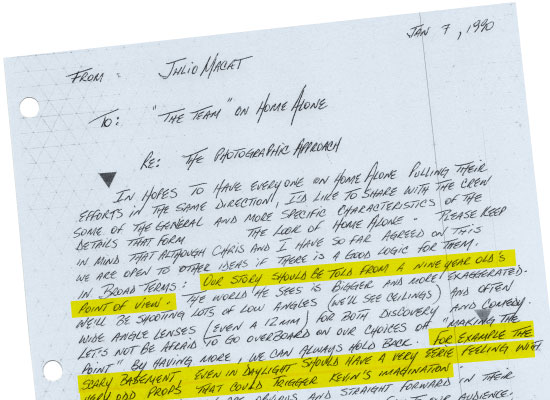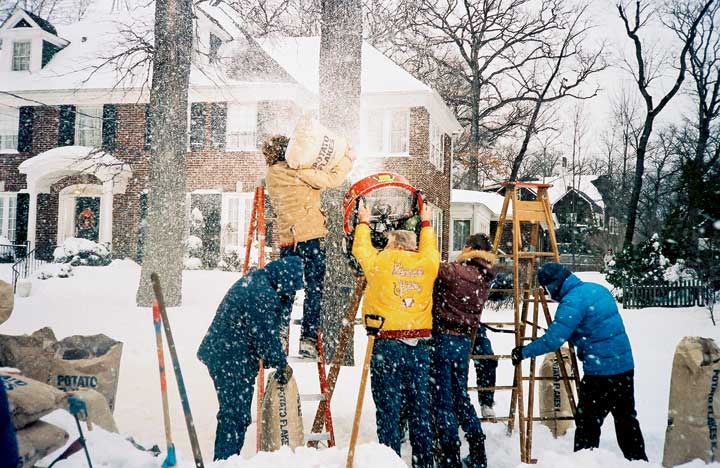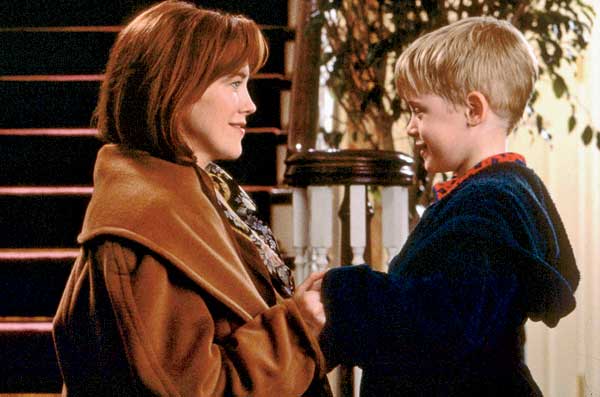On August 8, 1989, my father, John Hughes, jotted down in a notebook a movie idea, born of traveler’s anxiety, that occurred to him during the bustle of departing for our first family trip to Europe, and set it aside. Two weeks later, after returning home, he revisited the premise: What if one of the kids had been accidentally left behind?
Over the next nine days, he completed the first draft of Home Alone, capped by an eight-hour, 44-page dash to the finale. Before finishing, he’d expressed concerns in the marginalia of his journal that he was working too slowly.
Twenty-five years later, and six years after my father’s death, the filmmakers remain astounded at the worldwide reach of the “little movie” that first captured their imagination on the page. Shot around the North Shore, far from the reaches of Hollywood studios, Home Alone defied everyone’s prerelease expectations, becoming the highest-grossing live-action comedy ever made. To celebrate the film’s anniversary and its place in the holiday-movie canon, some of the key cast and crew have reunited to go home again.
Chris Columbus, director
In 1989, I directed Heartbreak Hotel, and it was a disaster. It opened on a Friday, and by Wednesday it was only playing at two o’clock in the afternoon. Around that time, John Hughes sent me the script for Christmas Vacation. I love Christmas, so to do a Christmas comedy had been a dream. I went out to dinner with Chevy Chase [the movie’s star]. To be completely honest, Chevy treated me like dirt. But I stuck it out and even went as far as to shoot second unit [collecting establishing shots and special sequences, usually without principal actors]. Some of my shots of downtown Chicago are still in the movie. Then I had another meeting with Chevy, and it was worse. I called John [who was producing the film] and said, “There’s no way I can do this movie. I know I need to work, but I can’t do it with this guy.” John was very understanding. About two weeks later, I got two scripts at my in-laws’ house in River Forest. One was Home Alone, with a note from John asking if I wanted to direct. I thought, Wow, this guy is really supporting me when no one else in Hollywood was going to. John was my savior.
Raja Gosnell, editor
Chris sent me the script. I thought, Wow, a movie starring a kid onscreen basically alone for three-quarters of the movie. That’s bold. I was intrigued, and I loved the message that this kid believes he wished his family away, discovers his self-sufficiency, and then they come back. It had all the emotions that went with a holiday movie.
During preproduction, a budget dispute between the producers and the studio, Warner Bros., jeopardized the project. Consequently, Warner Bros. put Home Alone “in turnaround,” meaning the screenplay rights could be acquired by another studio or financier.
Mark Radcliffe, associate producer
I remember it was on a Friday when I heard Warners decided not to make it. We were about three weeks away from production. The question was, “Do we lay everyone off?” John said to just hold tight.
Joe Roth, chairman of 20th Century Fox (1989–93)
I was having lunch with Jack Rapke [Hughes’s and Columbus’s agent at the time], and he told me Home Alone was costing $14.7 million and Warners would only pay $14 million. I said, “What’s the idea?” He told me. I said, “OK, if you can get it out of there, I’ll make it.” Seemed like a no-brainer. Didn’t cost much. I didn’t have a Thanksgiving movie. I liked the idea. I loved the people involved.
Mark Radcliffe
The next thing, it was a Monday or Tuesday and we had a deal with Fox to move it over there.
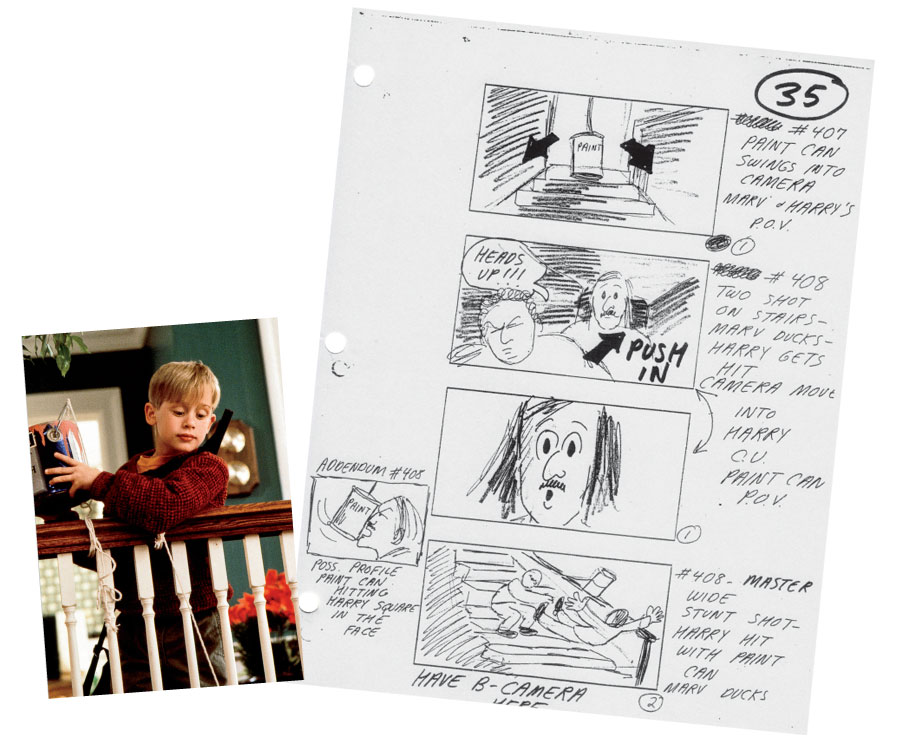

Right A production storyboard of the paint can stunt provided by Home Alone cinematographer Julio Macat
Crucial to the film’s success was the casting of 9-year-old Macaulay Culkin. Hughes had directed him in Uncle Buck the previous year and was mindful of a particular sequence that clicked: Buck (John Candy) leaves a suburban house temporarily unattended, and Miles (Culkin) assumes guard duty, staking out the front door mail slot for potential intruders.
Chris Columbus
I think John knew all along that he wanted Macaulay in the movie. I thought he was great in Uncle Buck, but I owed it to myself as director to see other child actors. John said, “OK, take your time, do what you need to do.”
Janet Hirshenson, casting director
When this started, the question was, “Is there anyone better than Macaulay? Not likely, but let’s see.” So we did a search through New York, L.A., and Chicago. You couldn’t really have anybody over 8. It had to be a kid who believed in Santa Claus.
Chris Columbus
I ended up seeing 200 other kids, looked over hundreds of videotapes. Then Macaulay read, and you immediately knew this was the kid. I knew subconsciously that John knew that was going to happen, but it was really sweet of him to give me that sort of freedom.
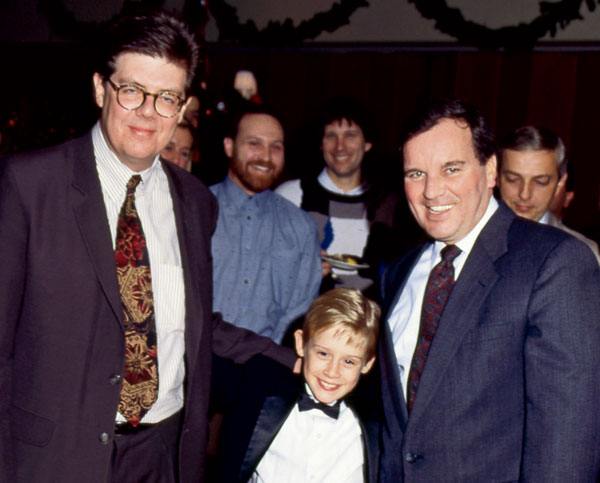
With the lead role secured, attention shifted to casting the film’s villains, the two hapless and dimwitted home-invading burglars, the Wet Bandits.
Daniel Stern, played Marv Merchants
The script struck a chord in me. I hadn’t gotten a chance to express that kind of physical comedy since I was a kid. I thought, I can hit a fucking home run with this. I went to an audition for Chris. I wanted it so bad. When I left, I thought, I could do that better. It was the only time in my life I called and said, “Can I come back?” Chris told me later he was already gonna cast me, but he saw me audition again.
Chris Columbus
Joe Pesci’s name came up in one of many late-night meetings until five in the morning with John. We knew he could do comedy from Raging Bull. [Pesci played Joey LaMotta, who relies on his wits to manage his irascible brother, Jake.]
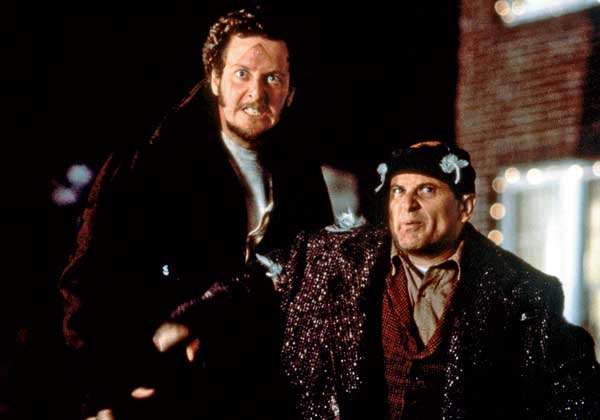
Roth was pleased with Pesci’s pairing with Stern, which he likened to the comic strip Mutt and Jeff—“a tall guy and a little guy.”
Daniel Stern
Everyone assumed we were thrown together for the first time on Home Alone, but we’d made each other giggle on the set in another movie years before that we were both cut out of: I’m Dancing as Fast as I Can. We played people in a mental institution. Joe walked around all the time with this rolled-up tube of architectural drawings. That was his character. And during one of the takes, there’s a Ping-Pong table in the middle of the room, and Joe takes his tube of paper and puts it up to his nose and snorts the line of Ping-Pong balls. I fell on the floor laughing. I became his friend right then.
Most of the actors playing the McCallister kids hailed from the Chicago area, though some, including Culkin’s younger brother Kieran, were cast in New York and Los Angeles.
Chris Columbus
Home Alone was a learning experience, working with kids who were that young. I wanted to hire kids who felt real. They didn’t necessarily have to start out as great actors.
Catherine O’Hara, played Kate McCallister
We’d have a kid on SCTV [the Second City sketch comedy series on which O’Hara was a regular] every once in a while, but Home Alone was the first time I worked with the rules of child actors. I don’t mean that like I’m complaining, because those kids were so cool. We’d shoot a scene with one of the kids; then, as late as one in the morning, we’d shoot my close-ups. They’d have a tennis ball on a stand, the height of the kid’s head, and the script supervisor would read the children’s lines.
Daniel Stern
I’d been narrating and directing The Wonder Years, so I’d been working with child actors. I understood what it takes to get those performances, and that’s where I think Chris was absolutely brilliant with Mac, who had such angelic qualities. You’re not necessarily casting a kid for acting abilities; you’re going with their energy. It’s their aura and what they can project, and you’ve got to handcraft it. It takes time and patience and love.
Janet Hirshenson
In Chicago, we worked with the talent agencies, and we went to Second City. There was a whole community there. It was always so much fun to cast the small parts out of Chicago. My God, actors galore.
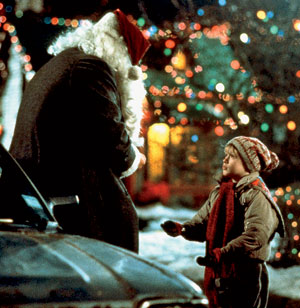
Chris Columbus
The guy who played Santa Claus, who I thought was a successor to John Belushi, was incredibly funny. He was from Second City, and I remember how hilarious his audition was.
Ken Hudson Campbell, played Santa
I drove out to New Trier. Chris Farley was already there; he was auditioning, too. It was 9 a.m. Apparently, he was out all night and had just been dropped off after a night of shenanigans, shall we say. Farley was kinda making catcalls to the girls who worked in the office. I was thinking, Oh, boy! The late, great Jay Leggett was also there. Chris went first. It didn’t go very well. He walked in and walked right out. I felt I went in and hit what I wanted to hit. A few weeks later, I got the call.
Filming began in February 1990, shooting throughout the North Shore and Chicago area.
Rich Moskal, director of the Chicago Film Office (1996–present)
Home Alone wasn’t set in suburbia anyplace—it was definitely tied to Chicago, and certainly tied to the Midwest. I think that’s part of what gave it its authentic charm. There was something about the freedom and ability for Home Alone—and other John Hughes movies prior— to work outside of studio oversight and maintain creative control. There was almost a conspiratorial excitement about that: We’re going to do it our way, without people looking over our shoulder.
Mark Radcliffe
We built sets on the stage at New Trier [West] High School, which at the time was closed. We were able to make a deal that allowed us to use it, originally, for offices, and then we basically ended up taking over the whole school. I remember in prep, during lunch, everyone would play roller hockey in the hallways.
Raja Gosnell
It was a bit of Home Alone for us—we were in this huge abandoned building that we could have the run of.
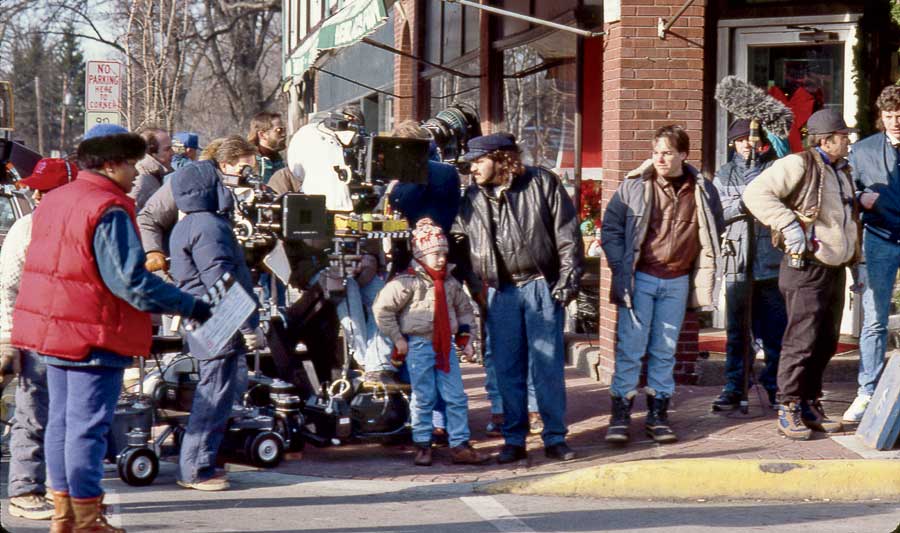
Jacolyn Bucksbaum, location manager
I’d actually scouted the [McCallister] house for Uncle Buck, and John Hughes didn’t select it. It was in my file box. When I met with Chris and John and the production designer, John Muto, to discuss the house, they wanted something more Oak Park, River Forest–like: a house that was more frame, more Victorian, not quintessential John Hughes, which was a traditional brick house. I had a hard time getting my head around it. The whole neighborhood, not just the house, had to work with all the master shots and POVs and sidewalk views. After two weeks of looking, I said to Chris, “There was this one house I remember from Uncle Buck.” We pulled up to [the house at 671] Lincoln Avenue in Winnetka and got out of the van. In two seconds, Chris said, “This is it.”
Cynthia Abendshien, former owner of the Winnetka house
We were told shooting would be four or five weeks. They gave us an apartment. But [Bucksbaum] explained that, under the contract, if they needed to knock down a wall when we weren’t home, they could do it. So she told us it was best if we remained on the premises. First of all, it didn’t take four to five weeks. They were setting up the production and dismantling everything for five and a half months. In that time, we spent maybe three nights in the apartment.
John Abendshien, former owner of the Winnetka house
In that house, there’s a master bedroom suite with four rooms. Basically, we just moved into that. We put a hot plate up there to cook. We didn’t have to cook that much, because we had full access to the food truck that the crew used, which our daughter, who was six at the time, loved.




